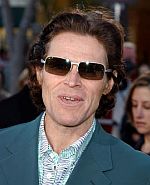A wiry, pale, sharp-featured veteran of experimental theater, Willem Dafoe soared to stardom and earned an Oscar nomination as Best Supporting Actor playing the Christ-like Sgt. Elias in the Academy Award-winning "Platoon" (1986). Prior to that performance, Dafoe used his menacing features and languid delivery to create an air of intensity for a succession of roles as toughs and villains. He made his feature debut as a poet-biker in Kathryn Bigelow's first feature, "The Loveless" (1981), an mannered film about the motorcycle mystique. Dafoe donned leather again as the vicious gang leader in Walter Hill's oddball rock-n-roll action flick, "Streets of Fire" (1984). He oozed erotic evil as a dangerous counterfeiter in William Friedkin's scalding "To Live and Die in L.A." (1985), a performance that attracted "Platoon" director Oliver Stone. After his tour of duty in Vietnam, Dafoe proved his versatility as a sympathetic, by-the-book FBI man in Alan Parker's well-intentioned Civil Rights period-piece, "Mississippi Burning" (1988). Being cast by Stone turned Dafoe’s career around, enabling him to transcend his on-screen villainy and specialize in roles depicting moral ambiguity and crises of the soul—men never at home with convention. A tormented Jesus fantasizing about sex with Mary Magdalene in Martin Scorsese's controversial "The Last Temptation of Christ" (1988), T.S. Eliot committing his wife (Miranda Richardson) to the insane asylum so he can move on with his poetry career in "Tom and Viv" (1994), and even a thieving, thumbless, morphine-addicted Caravaggio in Anthony Minghella's Academy Award-winning "The English Patient" (1996), are a few such characters. He returned crime, however, in 1997 as a computer-savvy terrorist who takes a luxury liner hostage in Jan De Bont's disappointing sequel, "Speed 2: Cruise Control".
Dafoe may inhabit the best of all worlds for a working actor in Hollywood—he gets well-paying leads: a cynical bombardier in "Flight of the Intruder" (1991) and a lawyer defending alleged murderer Madonna in "Body of Evidence" (1993); supporting roles: a sociopath in David Lynch's "Wild at Heart" 1990; and showy character turns: a jaded paraplegic vet in Stone's "Born on the Fourth of July" 1989, and a principled soldier of fortune in "Clear and Present Danger" 1994. Dafoe also has maintained his credibility in the theater community by remaining active in the Wooster Group, which he and longtime companion, Elizabeth LeCompte, the group's artistic director, serve as charter members. Appearing on stage in "LSD...Just the High Points", and the trilogy "The Road to Immortality", preceded his first starring turn for the company as the muscle-bound Yank in Eugene O'Neill's "The Hairy Ape" (1997).
Dafoe has never had a screen role to match the white heat of his performances in "The Hairy Ape", so it's little wonder he has resisted the temptation of going Hollywood when such artistic satisfaction can be had on stage. Mining a similar non-commercial vein, he has also periodically worked in adventurous independent and art-house films, such as "Triumph of the Spirit" (1989) and Paul Schrader's "Light Sleeper" (1992).
The actor remained busy as the new millennium approached, taking a variety of roles in Hollywood features and independents. Dafoe was effective as Nick Nolte's college professor brother in "Affliction" (1997), and gave a villainous turn as a menacing anthropologist in "Lulu on the Bridge" (1998). After playing a gas station attendant who wants to assassinate a computer game designer in "eXistenZ" (1999), Dafoe had a banner year in 2000 as an eccentric homosexual FBI agent in "Boondock Saints", a detective investigating the mysterious disappearance of a stockbroker in "American Psycho", and a prison inmate who takes a rookie kid under his wing in "Animal Factory", which premiered on Cinemax before its theatrical release. The actor capped off the year with a sensational performance as German actor Max Schreck in "Shadow of the Vampire", for which he was nominated for an Oscar for Best Supporting Actor. In this speculative behind-the-scenes look at the filming of the 1922 classic "Nosferatu", Dafoe was cast as the ultimate Method actor, and his delicious impersonation—he was unrecognizable under makeup—anchors the films, especially when Schreck engages in a battle of wills with director F. W. Murnau (John Malkovich).
Despite many successes, Dafoe sought new challenges. After returning to the stage with the Wooster Group in "North Atlantic" (1999), Dafoe was in a trio of roles as men of faith: as Father Ramirez in the independent "Bullfighter" (2000), as a missionary who falls in love with a spurned Chinese woman "Pavilion of Women", and as a Catholic priest sheltering Jewish children in Nazi-occupied Poland in "Edges of the Lord" (2001). In 2002, Dafoe played two vastly differing villains: the sneering, schizophrenic Green Goblin in the hit comic book adaptation of "Spider-Man", and the disarming and conniving John Carpenter, a sex addict and accused killer of 1960s sitcom star Bob Crane in Paul Shrader's "Autofocus". Shifting to animation, Dafoe was the voice of Gil, the hard-edged, but noble angelfish plotting escape from an Australian fish tank, in "Finding Nemo" (2003), Also successful that year was Robert Rodriguez's second El Mariachi sequel, "Once Upon a Time in Mexico", in which Dafoe played Barrillo, head honcho of the country's most profitable drug cartel and target of an assassination that El Mariachi tries to prevent. Meanwhile, Dafoe revived the Green Goblin for the equally successful sequel, “Spider-Man 2” (2004). After an earnest performance in the failed 14th Century murder mystery, “The Reckoning” (2004), Dafoe appeared in “The Life Aquatic with Steve Zissou”, the fourth film from the habitually smug Wes Anderson. As Klaus Daimler, he played the engineer on Team Zissou who can do no right--played completely straightfaced, Dafoe's performance was a comic gem. In “The Aviator” (2004), director Martin Scorsese’s epic biography about eccentric tycoon Howard Hughes, Dafoe had a cameo appearance as the editor of a tabloid magazine.



